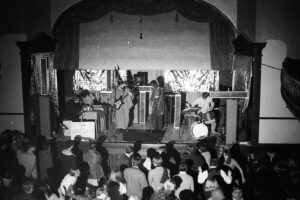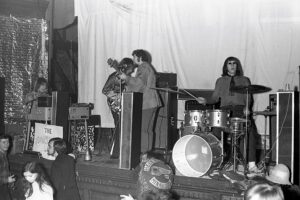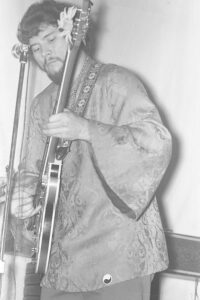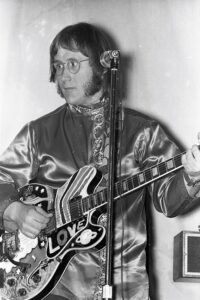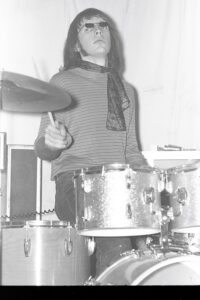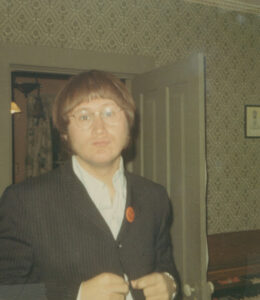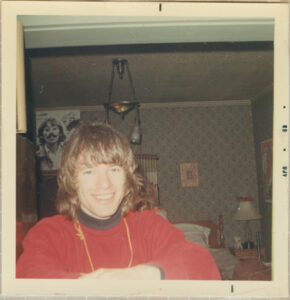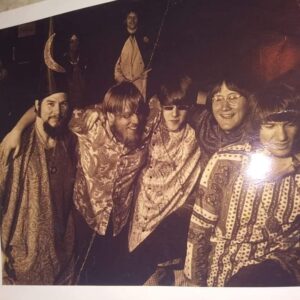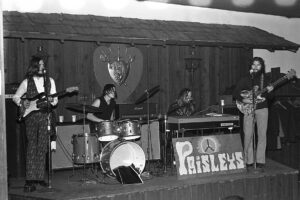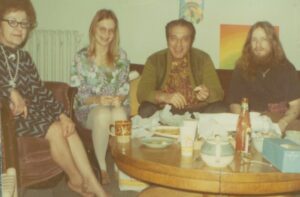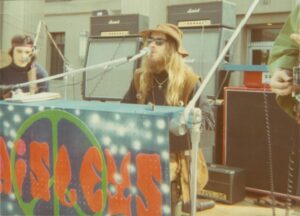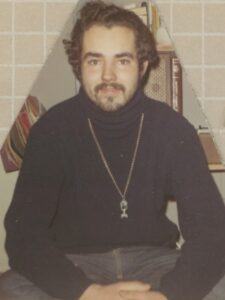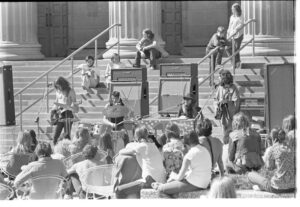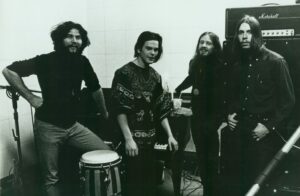Paisleys
A progressive – psychedelic rock band with one album released in 1970
Contents:
History
THE PAISLEYS – COSMIC MINDS AT PLAY
It was November 8, 1963. Richard Timm, from Minnesota, a member of the Naval Air Reserve, was on the Aircraft Carrier Midway, deployed from San Francisco on the “WestPac Tour.” As the ship steamed under the Golden Gate Bridge in San Francisco, Richard gazed up to admire the 1.7 miles long modern steel marvel, completed in 1937. The “Summer of Love” in San Francisco was four years in the future. Richard was already learning to play the guitar and would soon be playing in a military band that formed on the aircraft carrier.
Back in Minnesota, Bill Smith was a student at the University of Minnesota. He had been playing keyboards for a number of years, including a stint with Don Jacobson and the Furies. Richard and Bill were both graduates of Robbinsdale High School. A chance meeting would bring the two musicians together in three years.
Massive changes in music and culture lay just ahead in a decade that would be like none other. A musical journey was just getting started.
EARLY DAYS – A MUSICAL JOURNEY BEGINS
Richard Timm (known as Dick at that time) graduated from Robbinsdale High School, in Minnesota in 1961 and obtained a full-ride football scholarship to the University of Minnesota. However, just as the school year was about to begin, at the end of August, Richard, also a member of the Naval Air Reserve, was called up for active duty, by President Kennedy, because of the Berlin Crisis (the defacto partition of East and West Berlin by the USSR, with its earliest beginning in June, 1961). During his time in the service, Richard picked up a new pastime, teaching himself to play the guitar.
After serving in the military in Seattle for a year, he returned to the University of Minnesota in the fall of 1962 and resumed his studies, once again playing on the Gopher football team. Another year of active duty interrupted his college career in 1963, as Richard was eager to fulfill his military obligations. This time, Richard was stationed on the Aircraft Carrier Midway, which deployed from San Francisco on the “WestPac Tour” steaming around the western Pacific. Still learning guitar, he teamed up with some fellow military personnel, to play guitar and sing in a group they called the Purple Pythons. The band played on the carrier, as well as in ports of calls, in Hawaii, the Philippines, Japan, and Hong Kong. At a stop in Japan, Richard purchased a Sony TC500, a two track reel-to-reel tape recorder. Following his second year-long tour of duty, Richard returned to the University in 1964.
Back in Minneapolis, Richard moved to the West Bank area, just across the river from the university and joined the Minneapolis Musicians Union, Local 73. He was soon playing in a band (guitar and vocals) called the Pied Pipers which included guitar player and singer Dale Thompton . The band played cover songs at bars in the West Bank area. After the band broke up, Richard and Dale continued to perform for a brief time as a duo. In late 1966, the two of them were playing their final job at the Triangle Bar when Bill Smith, an acquaintance of Richard’s from Robbinsdale High (class of 1960), stopped in the bar and was surprised to see Richard up on stage.
Bill had played keyboards since high school, and at that time, Richard hadn’t been a guitar player. Bill had just graduated from the University of Minnesota, was working as a teacher’s assistant, and coincidentally lived just a half block away from Richard. Back at Robbinsdale High, Bill had been well known for his keyboard skills, playing at various school dances with a group called “Don Jacobson and the Furies.”
Richard started jamming with Bill at Bill’s place, they both were also writing songs, and encouraged each other to create original music. The Sony tape deck that Richard had bought in Japan was put to use recording demo tapes of their original compositions.. The two friends combined a number of songs that they had already written into a long musical piece they dubbed the “Musical Journey.”
Richard and Bill took a road trip to San Francisco in the summer of 1967 (the “Summer of Love”) to check out the west coast scene. Richard had visited California by himself in the prior year and was introduced to LSD for the first time. Both musicians were exploring the effects of the increasingly popular hallucinogenic drug.
Paul George was a graduate student, and also a teacher’s assistant, at the University of Minnesota, who became acquainted with Bill Smith. Bill invited him to come over and listen to one of the jam sessions, with Richard, and all soon became fast friends. Paul was sufficiently impressed with their efforts to suggest that, the two musicians form their own band, and offered to help them find work. Thus, he became the manager for the newly developing group.
Richard had met guitar player Rick Youngberg prior to becoming reacquainted with Bill Smith. Rick had been part of a popular Twin Cities garage band, the Deacons who had scored a local hit with “The Baldie Stomp” (written by Youngberg). After the Deacons had broken up, both Richard and Rick showed up to audition for a local band (name unknown) that was looking to hire a guitar player. Neither one got a call back, but Richard had been impressed at the audition by Rick’s enthusiasm and skill. Thus, when the band idea came up a month or two later, Richard called up Youngberg and invited him to come over and jam with them as a group. To facilitate the new mix, Richard made the switch to bass guitar. The three musicians hit it off and they decided to look for a drummer.
Rick Youngberg had a day job teaching guitar at Traficante Music, located in the Midway Shopping Center on University Avenue in Saint Paul. The store was owned by Ralph Traficante. At the store, Rick had posted a job opening for a drummer for their newly forming band. One day, Peter Larsen stopped by the store and noted the listing, and soon signed on as the band’s first drummer. Peter, a Saint Paul resident, had graduated from Cretin Hall High School in 1966 and had played drums with a number of garage bands prior to joining the Paisleys.
The new group focused on original material that could be described as Beatles inspired progressive – psychedelic rock.
Richard recalls the early days, “The creativity started bubbling out of our souls. All these social issues were erupting around the campus and then we had the Vietnam War. We weren’t doing things that the rest of the bands were doing or trying to copy what was being done. We were searching for something new. “
“HAPPENINGS” AT DANIA HALL – MUSIC – LIGHT SHOWS – A NEW DANCE
Richard lived with his wife and first child in an apartment building, where he also worked as a caretaker. The building was located within one block of Dania Hall, and when Richard walked by he would hear live music being played, as the hall had a third floor auditorium that featured local bands. Richard would often stop in and check out the bands, which at that time included Noah’s Ark and T.B.I. (True Blues Inc.).
Now a four-piece band, the Paisleys rented out Dania Hall in the later part of 1967 and put on their own concerts, complete with light shows produced by various people, including Gary Dale, Dick Tatge, and Lee Fletcher.
Richard states, “We could put our own dances on. We had full reign to do what we wanted.”
Dania Hall, located at 427 Cedar Avenue South, was a Victorian building built in 1886 with commercial use on the first floor, offices, and a meeting room on the second floor and an auditorium with a stage on the third floor with a horseshoe balcony above it on the fourth floor which was typically used to stage the light shows.
Richard recalls the shows at Dania Hall which were referred to as ‘Happenings’, “It was on the third floor. It was an old dance hall building that goes way back to the Danes, the early Danish immigrants who lived in that part of town. One time, there were about fifteen people up in the overhead balcony, shining various lights and projectors and strobe lights onto the stage, and this kind of magical thing just happened. It wasn’t planned in any respect.”
Peter recalls the early days at Dania Hall, “The hall had a history to it. There were names inscribed all over the back of the stage that go back to the beginning of the theater. You felt a presence, even with no people there. There was a warmth… a character to the hall, the smell of the wood… all of the timber and resonating of the wood lent itself to the performance. These were the physical things and then there was the invisible that went along with this… a spirituality. It was built as a place for people to gather, to share and to communicate. If you were going to perform, that was the place to perform. It was a different awakening or happening.
“The ambience and the sound contributed to this incredible atmosphere and it resonated with the music and the people. It was an open theater, one of the only kind in the city. It was a unique building. I just felt at home there with what we were doing back then.
“Because of the incense and the beads, it was like going to church. It was akin to a religious experience. “
Paul George had connections with people at the University of Minnesota and was able to book the new band for anti-war functions, strikes, and other gigs, both on and off campus.
A friend of the band named Clancy Cullen, a high school student, was acting as equipment manager. Clancy and his girlfriend, Becki (last name unknown) came up with a new dance that became known as “the circle dance.”
Richard remembers the origination of the circle dance, “Clancy and Becki were feeling exuberant and so they were swinging each other around. Pretty soon another person came into the two-some. Before long there were four, then there were five people dancing together. This spontaneous thing sort of developed and over the years it became a real ritual for the Paisleys. It was usually the last song we played. I think the largest one I ever saw was at Powderhorn Park where we were playing out there on the band stand and some circle dances developed, and it spread out into the ball field… that’s four ball fields big out there and the whole field was filled with hundreds and hundreds of people doing the circle dance. It was amazing. The circle dance was typically done to the ‘Musical Journey.’”
The Musical Journey became a jam song for the band and would often last around thirty minutes or so.
At that time, Paul George, along with Richard’s brother, Bill Timm were responsible for booking the band.
Another early supporter of the band was Tommy Smith, Bill’s younger brother who lived in California. Tommy would sit in with the band and sing lead vocals on a few songs, when he was in town, visiting Bill.
COUNTER-CULTURE RISING – CHANGES IN THE WEST BANK AREA
By 1968, the growing anti-war sentiment and various political and social issues were roiling the country and the universities became ground zero for various protests and demonstrations. The counter-culture movement was growing and Dania Hall and the West Bank area were reflecting the changes of the era.
Richard recalls, “It was a hodgepodge melting pot because it was on the West Bank, across from the university. At that time there had been this new bridge built across the river from the West Bank to the East Bank. So now students could cross the Mississippi on this bridge. All the strikes and all the street protests were going on in those times. The West Bank was kind of like the social center. We used to get all kinds of people down there at Dania Hall – Phil Richter had a pharmacy on the main floor and he went, ‘Oh this is great.’ He had never seen anything like this. ‘Hippies? What’s a hippie?’ All this color suddenly erupted on the whole avenue and then you had the moms and pops and kids from the suburbs driving down… gawking at all the hippies. It became a very colorful, exciting time. We were so engrossed in it. Dania Hall and the West Bank area of Cedar- Riverside was a living theater of personal discovery and creative imagination…. a renaissance of individual awakenings and expressions reflected in the language, dress, music, and arts.”
Peter remembers the interaction between the band and the audience at Dania Hall, “Crowd participation was important. Sometimes there would be three band members down on the floor with the crowd… banging on something. That was part of our uniqueness. We were really different. “
Dania Hall became a stop for a variety of local bands. In addition to Noah’s Ark and T.B.I., more local bands made their way to the hall in 1968 including Jokers Wild, Pepper Fog, the Litter, Lightning, Pandemonium Side Show, Mill City Blues Band, Nicollet Island Peep Show, Cold Duck and Blue Sandelwood Soap, among others.
For good or for ill, drugs were part of the scene at Dania Hall. Richard recalls, “There were certain drugs that had a positive influence. The only problem with drugs in those days that I saw was maybe somebody who was too drunk. Alcohol was always the big problem. I don’t think that hard drugs like heroin had moved in yet. There wasn’t the cocaine thing. Psychedelics were considered acceptable… LSD, mescaline… and eventually something called MDA, they used to call that the love drug. And of course smoking herb was always acceptable in most of those circles and also led to much social interaction between people.”
Richard states, “I went cosmic minded on all these drugs, absolutely. But, I made it through all that stuff. We always felt we had the teachings to go along with the use of these powerful mind drugs. We were cognizant of Timothy Leary and the pioneering work that Leary and his associates at Harvard did in mind expansion. Unfortunately, society’s fear prevented them from taking Timothy Leary’s teachings to heart. They made it illegal. If things would have been different, who knows?”
Peter recalls wearing a Kaftan shirt with long, flowing sleeves, made by his mother and leather moccasin boots that went up to his knees.
Peter states, “It was a common thing to dress different. You would know just from how people dressed back then what their beliefs were. This was a dividing point between people who did drugs and transcendence, spirituality, mentality…. and those who did not. There was a mini-revolution going on. It was a pivotal point. “
Rick Youngberg became aware of the Marshall Amplifiers which Jimi Hendrix was using and passed this information on to Ralph Traficante. Ralph was able to secure the franchise to sell Marshall Amps in the Midwest, which turned out to be a lucrative deal.
Richard states, “Once he got that Marshall Amplifier franchise, all the rock bands were buying them…”
The band members developed a close relationship with Ralph Traficante and his wife, Anita. The couple encouraged and supported the Paisleys and would have the band members and their families over for dinner on various occasions.
Traficante Music ran an ad for their store in Connie’s Insider, a local music publication, in their March, 1968 edition. It featured a photo of the Paisleys and comments that stated:
Excitingly New and Different!
The Newest Sensation in Psychedelic Sound!
Direct from Inner Space
In the band photo used for the Traficante Music ad, Richard is shown wearing a cone-shaped ‘wizard’ hat that was given to him by Rick Youngberg. Rick had spotted the hat at a local theatrical costume shop and purchased it for Richard to wear on stage. With the new, elongated hat, Richard picked up the nickname ‘The Wizard.’
As the band continued to play at Dania Hall, they developed a growing fan base. The local newspapers and other publications began to take notice of the band.
The Minneapolis Star (February 8, 1968, no writer listed) ran the following article.
Dania Hall Dances are ‘Happenings’
Music Brings ‘Fellowship’
Orange and blue lights flickered on and off. Blaring music called “acid rock” filled an upstairs room in Dania Hall near Seven Corners Wednesday night.
It was happening.
They are held on Friday and Wednesday nights, sponsored by a local band called the Paisleys.
About 40 persons sat on the floor watching band members on the stage. The ear-splitting music prevented conversation.
But when it stopped, a high school junior who had been leaping and skipping around the edges of the group in a modern interpretive dance fell to the floor and started talking about the happening.
She declined to give her name “because my parents and all the straight people will find out I was here and think it’s terrible.”
“I came because I heard there was going to be a sitar here tonight,” she said. “And I’ve never heard one played before.”
Besides the sitar, there were bongo drums, toy horns, wooden flutes, washboards and tamborines [sic] in the hall.
Posters advertising the dance had suggested that participants bring instruments and join in a jam session.
While the band took a break, the group of non-dancers sat on the floor blowing flutes and pounding the drums and washboards.
“It’s a concentrated effort to communicate through music,” said Gil Galiath, who works as a sliversmith in a Lake Elmo shop.
What is the message being communicated? “Fellowship,” she answered. “It’s just people being together doing something.”
She added that the dances are attended by University of Minnesota students, “wet ears” – “you know, teeny boppers,” she explained – but mostly by “just people.”
“It’s a cheap turn-on,” she concluded.
Donald Reynolds, a Minneapolis police officer who works at Dania Hall dances three nights a week offered an adult perspective.
Shaking his head he said, “They’re a group apart alright.
“You should see them Friday or Saturday night. Three or four hundred come, and they wear costumes – rebel outfits, hats, and weird coats,” Reynolds said.
“But these dances, with as many kids as there are, are less trouble than I’ve ever had bouncing at bars.”
On March 16, 1968, New City Opera House in Minneapolis featured the Paisleys, the Grasshoppers, and the High Spirits.
On April 6, 1968, the band played a job at a new club called Hullabaloo (a national franchise) in Fridley, a northern suburb of Minneapolis.
Connie Hechter, editor and publisher of Connie’s Insider, checked out the band at Dania Hall and wrote up an article, published in the March 30 – April 6, 1968 issue of the magazine.
PAISLEYS ARE STRONG BAND
My visit to Dania Hall in Minneapolis last week proved enlightening as well as entertaining. The Paisleys, a highly creative psychedelic–type band was holding forth, as they do every Friday at the hall, thoroughly entertaining the mixed crowd of hippie-types and serious pop-music fans.
The quartet is original in material which is danceable, unlike some other bands I can think of which like to feature their own material. Their secret is a pronounced rhythm which conveys the basic beat at all times.
The band also wears what might be considered to be the closest thing to the San Francisco look in town, and it definitely adds to its total audio-visual image.
Despite its psychedelic bag, they do not “freak out” to the point of nonsense.
The Paisleys light show not only works, it is effective, again adding to the desired overall effect.
This band could handle any club or dance date, providing “something different and exciting” often desired by pop music fans who are in the know.
The Paisleys can be booked by calling Paul George or by contacting Bill Timm.
They renewed my faith in the psychedelic bag.
In April, 1968, an unknown publication referred to the Paisleys music as “Love Rock.”
A new local group called the Paisleys has come out with its own version of the hard rock sound: they call it Love Rock.
The group’s members perform mostly original material and the general connotation of their music is that of the ‘Love Generation’ variety.
Pat Paulsen was a comedian who had gained popularity as a frequent guest on the Smothers Brothers television show. He developed a shtick where he was a candidate running for President of the United States, a member of the S.T.A.G. (Straight Talking American Government) political party. Paulsen came to the University of Minnesota on April 10, 1968 and held a show at the Great Hall in Coffman Memorial Union. The Paisleys opened up for Paulsen.
On April 16, 1968, Peter Larsen enlisted into the military service, just twelve days after he joined the Musicians Union (as noted in the musicians’ union files). Therefore, the group held auditions at Dania Hall for a new drummer. Greg Payton tried out for the job and became the second drummer for the band.
On May 4, 1968, the Paisleys and Susie Q and the Originals opened up for the Litter at New City Opera House in Minneapolis.
On May 22, 1968, a publication (not identified) ran an article by Keith Kellogg on the Paisleys that provided some insight into the band and the times including the reasoning for the band’s plan to move to Canada.
Dania Hall’s Paisleys play own brand of ‘love-rock’
Group – ‘one big family’ – will emigrate to Canada
The Paisleys say they are an unusual band – unusual in their sound, in their working relations, and in their philosophy toward the music business.
The group calls itself “one big family” that would be just as happy if the members were “digging ditches together.”
Formed about six months ago, the Paisleys have played regularly at Dania Hall, 427 Cedar Ave., on the west bank, since January.
The band is in the running for three 1968 “Connie” awards given to rock bands in the Upper Midwest. Sponsored by Connie’s Insider, a trade journal of the music business, the nominations are for best new material, most promising new band, and best show group.
The Paisleys play a driving electric sound they call “love-rock,”
“It’s supposed to make people happy,” Paul George, a 27-year-old manger of the group, said in an interview last week. “Some groups play tense music. We’re more relaxed.”
George, a graduate student in genetics, said the group writes down only chords and words to its repertoire of about 35 songs with names like “Sha-La-La” and “Orange Fuzz.”
“But a lot of music isn’t planned before a performance,“ he added. “Something different happens every night. If we tried to practice and make it this way, it would never happen.”
Unlike most rock bands, according to George, the Paisleys play only their own music.
“We feel that you can only really get in on the feeling of your own thing,” he said. “When you listen to a band play somebody else’s song, you can’t help comparing it, instead of really listening , you’re playing a game.”
And, according to George, Paisley music demands concentrated listening. Of the 200 to 300 persons who come to Dania each Friday and Sunday night – a mixture of teenyboppers, college students, and hippies – less than half dance during a song. The rest sit around listening and watching the band, the dancers, and the light show.
The light show, which George said is “getting more and more important to the performance,” is run by Lee Fletcher, 21, and Gary Dale, 21.
The music itself is produced on $5,000 worth of electronic equipment. Rick Youngberg, 22, plays lead guitar. Dick Timm, 27, plays bass guitar and 12-string. Greg Payton, 22, is drummer, and Bill Smith, 25, plays electric piano.
Smith, a psychology teaching assistant in General College until the end of December, has played classical piano and still does “whenever I get a chance.” But he prefers the freedom of playing music that is “anything I want it to be.”
According to Smith, some of the group’s songs contain threads of classical music. “On hearing the music,” he said, “more than a few people have commented, ‘Yeah, Beethoven.’”
How good is their music?
Band members describe it as “groovy” and “outa sight.” But Smith said, “When you’re completely involved, you don’t think of whether it’s bad or good. You just get behind the vibrations.”
He added that there are two ways of judging the music: objective – “commercial success doesn’t have any meaning for me,” he said. But the group has attracted about 150 followers who come to Dania almost every week.
The Paisleys said one reason for their special sound is the close relationship among the members.
“We’re unique because we’re not just a group, we’re a way of living,” said Youngberg.
Smith, who is married, said, “the whole thing is a tribe – the band, the light show, the wives, the girlfriends.”
“I think the way it is now,” said George, who is married and has three children, “we’d stick together even if we were digging ditches. The music is a product of this kind of love vibration. Many bands aren’t this way. They regard music as a business. But the great ones, like the Beatles, live close to one another in their group.
“If the members of the band like each other, the lines of communication are open. A suggestion that might improve the music is well received.” George described the group’s attitude toward money “not really hard-nosed.”
Sometimes he lets in regular followers for less than the $1.50 admission and, “I tell them to make it up. And I let somebody in once for a police whistle.”
“Money cuts hang up a lot of groups,” he said. “The little we’ve got we divide as fairly as possible.” But, all of one night’s earnings once went to Timm when his wife had a baby.
George said 82-year-old Dania Hall has been important to the Paisley’s success because there the group can run its own show and because the audience is allowed to be “uninhibited.”
“At many places cops really hassle the kids,” he said. “At one dance hall that we played, two kids were necking and a cop kicked them out. At Dania, everyone does what he wants.”
Whether or not they win a Connie award and cut a record, the Paisleys have decided to move permanently to Canada – not because they’re dissatisfied with their Minneapolis success, but Smith said, “for our safety.”
Although all the group’s members are ineligible for the draft, Smith said the Vietnam War, the possibility of summer rioting, and the members’ long hair (one member was attacked recently and given two black eyes) all made them decide to emigrate to Vancouver, British Columbia, at the end of June.
“We’re looking for a less violent society,” he said, “a place we can be free to develop.”
In the article, there is a reference to a song by the band called “Sha-La-La.” This appears to be a typo, as the label of a reel-to-reel tape, recorded at the time lists a song titled “Cha-La-La.”
The Connie Awards were held on May 27, 1968, sponsored by Connie Hechter. The Paisleys were nominated in three categories, Best New Material, Best Show Group and Most Promising New Band. However, Candy Floss Productions won the award for Best New Material for “Oscar Crunch” recorded by Nickel Revolution, Happy Dayz took home the award for Best Show Group, and the Sparklers won for Most Promising New Band.
Bill Smith states in the article that one of the band members was assaulted. Richard Timm believes this incident refers to Rick Youngberg, who was jumped by a group of men that destroyed a Sitar he was carrying.
Although Bill Smith refers to the band members as being ineligible for the draft, this cannot be confirmed. Richard Timm had already served in the military and was not subject to the draft. With a large number of the band’s members and friends (those that were going to Canada) being young men in their twenties, it would seem likely that one or more of the guys in the group were eligible for the draft.
In 1968, the Vietnam War played a big role for men who were subject to the draft. In order to avoid being called up, some people sought deferred status, mainly by enrolling in college or by faking a physical or psychological condition, one that would result in being classified as unfit to serve. Some sought conscientious objector status. A large number relocated to Canada to avoid the whole issue.
NORTH TO CANADA – A CARAVAN HEADS TO VANCOUVER
In June, 1968 the Paisleys and their families and a number of their friends left the United States and headed north to Canada. The group consisted of Richard Timm and his wife Janice and their two children, Bill Smith and his wife Diana, Rick Youngberg and his wife Vickie (a.k.a. Blossom), Greg Payton, Paul George and his wife Carol and their three children, Gary Dale and his girlfriend (name unknown), Lee Fletcher and his girlfriend Sheri Scott, and Bill Matzke (a.k.a. Bilbo Baggins) all packed up their vehicles and headed north – fourteen adults and five children in six vehicles-caravan style, to Canada, camping out along the way, and eventually settled in Vancouver.
In Vancouver the band played gigs in large venues at Simon Frazier University and the University of British Columbia, as well as smaller venues and some outdoor jobs. However, despite the income from these paying gigs, the band was not making enough money to make a living.
Richard went to work for Boeing (in Everett, Washington) as a ‘Structural Steel Mechanic’, assembling the scaffolding to be used in the construction of the very first 747 passenger plane. He also sought treatment for a recurring vision problem at the VA in Seattle.
Greg Payton became ill in Canada due to diabetes and could no longer continue on as the band’s drummer. Greg returned to Minnesota, and the band held auditions for a new drummer. Bob Belknap was a drummer in Vancouver and had just left a band called The Yellow Brick Road. Bob tried out and got the job. With Bob in the band, the group played a number of frat parties at the University of British Columbia and also played at the 4th Avenue Bistro in Vancouver.
BACK IN THE USA – RECORDING WITH WARREN KENDRICK
Bill Smith and Paul George seem likely to have originated the idea to relocate to Canada, since both had early on applied officially to the Canadian government for them and their families, to be admitted as immigrants. Even though these four adults and their children were the only official immigrants, this did not seem to pose a problem for others in the group, with the exception of Rick Youngberg and his wife Blossom. When Canadian authorities discovered that the two were not legally in the country they were ordered to leave Canada. Rick and Blossom returned to Minnesota, soon followed by Richard (and his family), as he needed to have eye surgery. By early 1969, most of the group had returned to Minnesota. Paul George and his family stayed in Canada.
Bob recalls, “So it ended up just Bill and myself staying in Vancouver and Bill wrote “Smokey Windows” and a couple other tunes and I just worked out the arrangements with him, the rhythm. In February we drove back from Vancouver together. Rick was playing in a trio at that time, Cottonwood, and he didn’t want to leave that band and rejoin the Paisleys. Bill and I were living in St. Paul near Hamline College and we put up some posters, got the word out that we were looking for a guitarist. And so Brad Stodden answered the call and came and auditioned, and he knew every lick that Rick ever played. He could do him to a T.”
Brad Stodden, from Whitefish, Montana had just graduated from Hamline with a BA in English and a BA in Philosophy. Brad moved in with Bill Smith and his family who had a home located two blocks west of Hamline College in Saint Paul.
Richard recalls when Brad, “When Brad joined the group he had all of his own equipment, except it was home stereo gear, not big amplifiers for playing live in dance halls. He was a very gentle person… bright, good sense of humor. He picked up Rick’s leads and embellished his own style very quickly… a master at sustained feedback notes. Brad had a very intelligent- open-mind, curious, creative, and the band was very fortunate to have him fit in right away.”
With the band now back in Minnesota and with a new guitar player, they returned to playing gigs in the Twin Cities, including their old haunt, Dania Hall. At this point in time, Richard Timm’s brother, Bill took over as the sole booking agent for the band. Since the group did not play Top-40 dance music (most clubs and bars were looking for cover bands at the time), this resulted in some difficulties getting jobs for the group.
Richard recalls, “I think he ran into some problems, because we were so uniquely different, and we’re being categorized in this cliche of…‘they’re a psychedelic band….’ ‘they’re a love band….’ ‘they’re a hippie band‘ and some of the places he’d been doing business with just weren’t hiring groups like that. So eventually, he admitted he just couldn’t book us.”
The band members then sought out local booking agent Marsh Edelstein of Marsh Productions. Bob recalls, “We went down and talked to Marsh and I believe Ralph Traficante set up that meeting and everything clicked. Our personalities clicked with Marsh. He definitely clicked with us and he started booking us.”
The Paisley’s made a connection with Warren Kendrick, a local songwriter, producer, engineer and record company owner. Warren had developed a track record of successful recordings released on his various labels by Minnesota bands. These included the Litter, the Electras and White Lightning, among others. Warren had a building on East Lake Street in Minneapolis and struck a deal with the band where they would build out the interior studio space with the intention of recording their first album there, when the studio was completed.
Richard believes that Ralph Traficante may have contributed financially to the band so they could record their album, however details at this point in time are murky at best regarding the details.
Richard, “So the Paisleys were hired by Warren Kendrick then to build that studio, 3009 East Lake Street, ‘Audio City’… that studio was built under the direction of Warren Kendrick and the Paisleys did most of the manual labor.”
The four-track studio was completed in the summer of 1969 after about two months of work. In the fall of 1969, The Paisleys began recording an album with Warren as engineer and producer.
LOVE IN CONCERTS – FESTIVALS AND OTHER GIGS
The summer of 1969 brought forth a large number of “love in” concerts that were held outdoors.
Richard recalls, “A lot of them were held downtown right on the mall. Some were held over at Loring Park. Some were held at Stevens Square, in the Art Institute park there, Fair Oaks, and also at the University, down on the river. Riverside Park had a lot of them too. Powderhorn was another one.”
What was a love in concert? Richard explains, “We were promoting peace and love. That was the by-word of the day. Love your brother. Love your sister. It was multi-cultural. It transcended the races. I don’t think there’s been a larger movement on the planet Earth in modern times.”
In 1968 and 1969, there were summer softball games between different bands and other teams. Members of the bands and their road crews would also participate. Richard recalls one of the more unique softball teams the band played, “We went into Stillwater Prison, near the Wisconsin border. At that time we were known as the ‘West Bank Heads.’ We went out there and they had a ball field. They beat us really bad. Those prisoners were so good.” A planned ball game between the ‘Heads’ and local law enforcement members was never realized.
On September 18, 1969, the Paisleys gave a performance at Donaldson’s (a department store) in downtown Minneapolis, as part of the “Soul of a City” Arts Festival, which ran from September 18, 1969 through September 28, 1969. Lonnie Morgan, a former Gopher football player and a friend of Richard Timm, was the director and founder of the festival.
Sometime in October, 1969, Marsh Edelstein booked an invitation-only show to promote the band to music industry people. The event was held at the Cedar Village Theater which was located in the West Bank area of Minneapolis. The exact date of this promotional event is unknown.
On October 7, 1969, Bob Belknap traveled to Canada, planning to return on the tenth, only three days later, but ran into immigration issues when he attempted to come back, ironically, due to his wife being a US citizen. This delayed his return to Minnesota considerably. Clancy Cullen located Mike Cornelius, a sixteen year old high school student, to take over on drums. Mike lived with his family in a large house on Lake Calhoun in South Minneapolis. The band often gathered there to rehearse the basement of the residence.
On October 16, 1969 the Paisleys played at Magoo’s in Minneapolis. Playing on that same night in the adjacent New City Opera House was Santana, just two months (to the day) after they had performed at Woodstock.
After playing a job at the Red Baron in downtown Minneapolis, a fire broke out after the club was closed for the night and all of the band’s equipment (which was left in the building overnight, as they were scheduled to play the next night) was destroyed. The Marshall Amplifiers were covered by insurance through Traficante Music, but everything else was a total loss.
The Minneapolis Star reports the Paisleys played three jobs in November, 1969 at the Coffeehouse Extempora (located in the West Bank area, near Dania Hall) and one job at Times Square in downtown Minneapolis, with three other local bands on the bill. There is also an ad for Scotch Mist, a downtown Minneapolis bar, that lists the Paisleys playing there along with other local bands.
The same newspaper indicates the band played two jobs in December, 1969, one at the Coffeehouse Extempora and a “Festival of Hope” show held on December 23 at the Minneapolis Armory. The Christmas season event was organized by the Reverend Roger Paine of Plymouth Congregational Church. In addition to live bands, the event also included a light show, a theatrical performance, readings, a slide show and experimental films, according to an article in the Minneapolis Tribune (December 21, 1969).
The newspaper reported on the concept of the festival.
Mr. Paine stated, “This is not a concert and not a traditional religious service. There will be no emcee, no haranguing speeches. It’s not an anti-war rally. It’s a pro-peace party.”
Recording the album at Audio City continued into the later months of 1969. The band believed there was an agreement for Warren to deliver the finished tape to Marsh Edelstein and that Marsh would “shop the tape” to record companies in New York, with the hopes of securing a record deal for the band. However, this did not happen. The circumstances surrounding this agreement, and what actually transpired, are not clear to this day.
Although Warren had used several label names for his previous releases, it was decided that a new record label name would be used for the Paisley’s album.
Richard explains, “I had suggested the “PEACE” label. The peace sign was kind of universal at that time. Bill drew the cover of the album. Marsh was very high on the Paisleys. He thought we were uniquely different than most of the other bands. But he also was a booking agent so he had a lot of bands and at the time he had made arrangements out on the east coast to be visiting some of the bigger recording companies and publishing companies. His idea was to be going out and to show his bands and try to gain contracts at another level of the business. He had anticipated and expressed that we were going to give him the Paisleys finished tape to take out there to showcase the group. That never happened and we did not know about this until later.”
The band’s relationship with Warren Kendrick and Marsh Edelstein eventually came to an end after the album was released. The band, the producer, and the booking agent moved in different directions.
The December 20 -27, 1969 edition of Connie’s Insider reported that KQRS was playing “Wind” by the Paisleys, a song from their new album.
Bob recalls, “What we were doing back then in ‘69 was… when we would record a song a lot of times we would get a cassette tape of it and we would go to KQ and give them a promo tape and Alan Stone would play it at night. KQ was a different entity back then. It was considered an underground FM station.”
“COSMIC MIND AT PLAY” RELEASED – A NEW DECADE BEGINS
In early 1970, “Cosmic Mind At Play” by the Paisleys was released on the PEACE label as it’s first item in the catalog: PEACE LP 70P-1. 2,000 copies of the album were pressed. Bill Smith did the art work for the front cover of the record jacket. The back cover provides song lyrics and a photo that shows (left to right): Richard Timm, Mike Cornelius, Bill Smith, and Brad Stodden. For some unknown reason, Bob Belknap was not shown in the photo and was not listed in the credits on the production run of the album (this oversight has been corrected below). The album consists of seven songs.
Cosmic Mind At Play
Song List:
Side 1.
Song 1. “Cosmic Mind At Play” (Richard Timm and Bill Smith)
Richard Timm: Lead vocals and bass guitar.
Bill Smith: Backing vocals and keyboards.
Brad Stodden: Backing vocals and guitar.
Bob Belknap: Drums.
Song 2. “Rockin’” (Richard Timm and Bill Smith)
Bill Smith: Lead vocals and keyboards.
Richard Timm: Backing vocals and bass guitar.
Brad Stodden: Backing vocals and guitar.
Bob Belknap: Drums.
Song 3. “Now” (Richard Timm and Bill Smith)
Richard Timm: Lead vocals and bass guitar.
Bill Smith: Backing vocals and keyboards.
Brad Stodden: Backing vocals and guitar.
Bob Belknap: Drums.
Song 4. “Smokey Windows” (Bill Smith)
Bill Smith: Lead vocals and keyboards.
Richard Timm: Backing vocals and bass guitar.
Brad Stodden: Backing vocals and guitar.
Bob Belknap: Drums.
Song 5. “Diddley” (Bill Smith)
Bill Smith: Lead vocals and keyboards.
Richard Timm: Backing vocals and bass guitar.
Brad Stodden: Backing vocals and guitar.
Mike Cornelius: Drums.
Song 6: “Wind” (Bill Smith)
Bill Smith: lead vocals and keyboards.
Richard Timm: Backing vocals and bass guitar.
Brad Stodden: Backing vocals and guitar.
Mike Cornelius: Drums.
Side 2.
Song 1. “Musical Journey” (Richard Timm and Bill Smith)
Richard Timm: Lead vocals and bass guitar.
Bill Smith: Lead vocals and keyboards.
Brad Stodden: Backing vocals and guitar.
Mike Cornelius: Drums.
After its release, the album received airplay on KQRS and KUOM, the University of Minnesota radio station.
Richard recalls the impact of DJ Alan Stone at KQRS on the success of the album, “He introduced the album to his audience. He was the first to play it. He also wrote the liner notes on the back of the album.”
The album liner notes from the back cover:
“What it all distills down to, of course, is vibrations… feelings. A group delivers a sound that does nice things to you or it wastes your time. The sounds in this album represent a philosophy; and attitude; a joyous, irrepressible approach to life and music… and a devotion to detail and quality rarely found in the jumbled, eye-on-the-clock-and-the-pocketbook world of recording and mixing. Here then are The Paisleys…complex; mystical; involved. Yet unpretentious. Here is their musical philosophy; and affirmation of the importance and happiness in life… and it is; as it should be. I hope that you enjoy this album as much as we have… and do… on ‘NIGHTWATCH.’”
Peace
Alan Stone
KQRS Radio, Minneapolis
The progressive-psychedelic songs on the album range from the light to heavy modes. “Now” seems to be the most tripped out song on the album with a lot of psychedelic sound effects and lyrics that refer to another world beyond this one:
“Now as we awake to the super conscious state
Now as we traverse through heaven’s golden gate
Arriving at last upon the radiant shores of the pure spiritual realms
Knowing at last our long and weary journey is done”
“Smokey Windows” also has lyrics that lean in a spiritual direction:
“Just listen to the voice that comes from the void
And you will probably be saved
And the apple will be peeled and the truth will be revealed…”
The last two minutes or so of “Diddley” are filled with a mash-up of keyboard parts, bass guitar, guitar feedback and weird vocalizations, now referred to as “concrete” in music lingo.
“Wind” is a slow paced moody song with an ominous keyboard arpeggio and a heavy, distorted lead guitar. The trippy lyrics (repeated over in the song) are:
“Listening to wind blowing through your mind is blowing with the wind”
The entire B-side of the album is “Musical Journey,” an 18-plus minute opus of numerous songs that are stitched together.
Richard and Bob offer comments on the album:
“Cosmic Mind at Play”
Richard: “I was having my mind expanded and through the psychedelic 60’s. My mind became cosmic and I thought – how appropriate. And so I would show my part of that song to Bill and then… ‘Oh yeah, let’s add this part….’ He would add a bridge to it, another part to, it so that’s how everything came together.”
“Now”
Richard: “It was kind of what we were going through. The first part of the lyric, ‘Now as we awake to the super-conscious state.’ This was a journey that was going on within at least myself and what I could perceive with the people around me. So we were on this… expanding to a cosmic sense of awareness and little did I know that really we were just doing nothing but trying to listen to our inner spirit…. which helped direct us to a higher state of living.”
“Smokey Windows”
Bob: “’Smokey Windows’ originally referred to a vehicle that you would be smoking pot in and then the windows would get all fogged up, cause that happened to Bill and me one time. Bill wrote that in Vancouver and it was a fun song.”
“Diddley”
Richard: “’Diddley’ is based on that rhythm that Bo Diddley would have come out with, that one-chord jam.
Bob: “I didn’t play the Bo Diddley drum beat to that song. I made up my own drumming to it.”
“Wind”
Richard, “When Brad was living at Bill’s house upstairs, Bill was down in his basement working on this ‘Beethovian’ piece, writing ‘Wind.’ Upstairs, Brad was listening to it so while Bill is writing this song in the basement, Brad is upstairs… writing the lead guitar part. Later Bill came up and said, ‘Brad, I wrote this new song, come on down and listen to it.’ So Brad went down and listened to it. Then he plugged in and starts playing the lead, and it was just magical. It fit together like a finger in a glove. ‘Wind’ reached that crescendo of release, and then silently resolved back in, and one of Warren’s genius ideas was to phase in this wind, that sound effect and phase it back out. And that was one of Warren’s contributions. “
“Musical Journey”
Richard, “The ‘Musical Journey’ was a compilation of individual pieces that both Bill and myself had written previously.”
Richard now feels it is important to stress the fact that the album was a transactional coming together of creative individuals and not the sole output of any one of the band members.
PROTEST EVENTS – FESTIVALS – MORE LIVE GIGS
April 3, 1970 was an historic day in Minnesota music history. It was the opening night of The Depot in downtown Minneapolis. The venue was a former Greyhound Bus Station with a totally renovated interior with bars, a dance floor and a large stage. Joe Cocker was on his ‘Mad Dogs and Englishmen’ tour and was scheduled to play two nights in a row.
Richard recalls opening night, “The first night the opening act was the Paisleys, so we opened The Depot. The second band was the Flying Burrito Brothers and then Joe Cocker and towards the end of the concert, Joe Cocker and his band had ‘forty-eight’ people on stage that night… the women, the kids, the groupies, and even the dogs were there. Leon Russell was on keyboards. And then the very last song, they brought out these long boxes of long-stemmed roses. There must have been a couple of dozen boxes of roses that were opened on stage and they threw the roses out into the audience. It was a very memorable experience.”
On April 18, 1970, the Paisleys performed at a “Peace Festival” held at the University of Wisconsin at Eau Claire, 100 miles to the east. The concert was scheduled to be held outdoors, however rain forced the show to be moved indoors. Also on the bill were Mandrake Memorial, Townes Van Zandt, Zulu, Cottonwood (with Rick Youngberg on guitar), Thundertree, Pepper Fog, the Marauders, Seaman’s Mark, and Chesterfield Gathering.
The very first “Earth Day” was on April 22, 1970. A protest was held that day outside the Minneapolis Auditorium, where there was an annual meeting taking place of General Electric shareholders. The protesters then made their way to the nearby Wesley United Methodist Church, where there were speeches, live music, and people blowing on kazoos. The Paisleys performed at the church for the “Earth Day Protest.”
Minneapolis Star writer Peter Ackerberg was there to report on the event (published April 23, 1970) as follows:
“They can poison us to death while we blow our kazoos. We must not be just kazoo blowers,” the speaker said.
Cheering. Then a din arose from the church crowd.
They were tooting on kazoos that had been quickly passed out.
The article also mentions the Paisleys.
On the pulpit, four rock musicians – The Paisleys – performed “Wind,” “Clouds,” “Sunshine Morning” and “Cosmic Mind at Play.”
The Minneapolis Star reports that the Paisleys played for an event called the “Environmental Rock Festival” held on April 26, 1970, at the plaza over the River Road parking ramp. Also on the bill were local bands the Del Counts, Pepper Fog, Mojo Buford Blues Band, and a trio known as Bear, Beaver, and Peacock.
When the Paisleys and their friends needed a break from city life, they would take some time for rest and relaxation in a rural setting on a farm owned by Dave and Rose Hanson in New Prague, about forty-five miles southwest of the Twin Cities metro area.
On May 9, 1970 there was a large anti-war march that took place on Summit Avenue in St. Paul with the protesters walking to the State Capitol, about eight miles east of the U of MN campus. Thousands of people participated with one estimate at 20,000 people (Star Tribune May 10, 1970). The exact number of participants is likely unknown. The Paisleys performed just outside the Capitol at the top of the massive steps that lead up to the building.
Richard remembers the event, “The Paisleys were on the Rotunda steps at the Capitol. We were setting up the equipment. We looked inside the Capitol and all these guards inside were chaining the doors. They probably thought there was going to be a riot. As I heard it, a hundred thousand people came marching arm in arm down Summit Avenue onto the Capitol grounds, up towards the Capitol and it’s the Paisleys that are playing. I always thought as long as we were playing it was going to be peaceful. We would play downtown Minneapolis, in the midst of Nicollet Avenue being surrounded by thousands and thousands of people protesting and it was the music that kept them from freaking out, as far as I am concerned. And at the Capitol we’re standing next to guys like these A.I.M. guys, the American Indian Movement, and these guys are really angry. They’ve got really legitimate reasons to protest. It was a renaissance of activity in that time period. The protesting of the war was kind of coalescing everything together. You got the Native Americans, you got the Black Panthers… you got all these racial groups coming together…”
Photos taken by local band photographer, Mike Barich, show the band playing outside of Northrop Auditorium (by the front steps) on the University of Minnesota campus on May 17, 1970.
On Memorial Day, May 30, 1970, the Paisleys played at the State Fair Hippodrome in Falcon Heights, about six miles east and north of the University of Minnesota campus. The event went from 9:30 AM to 11:00 PM and was called “Bacchanalia Revival,” and also included Shocking Blue, Ike and Tina Turner, Tony Joe White, Steam, Zarathustra, the Youngsters, and Fairport Convention.
Writer Bob Lundegaard reported on the event in the May 24, 1970 issue of the Minneapolis Tribune and stated that John Brevick, a twenty-eight year old entrepreneur who co-owned a stereo system manufacturer, produced the event, his first venture into putting on rock shows. Brevick’s company sold octagon-shaped speakers called ‘Astro-Speakers’ that could be suspended from the ceiling or used as end tables or chairs.
Richard remembers the show, “We went to that gig. We went real early. The Hippodrome floor was all dirt because that’s where they had the horses. We’re laying out there on the dirt floor, about three quarters of the way back, right in the center. So we’re at a real good observation point to listen to the sound system, and they had…. I don’t know… it seemed like fifty speakers on either side of the stage… and it was so loud… and we had done these orange sunshine barrels-LSD and we were just flying… and we heard all these bands, and I remember really specifically Ike and Tina Turner… when they got on… man it was cooking by then… but it was so loud you couldn’t really hear anything. We got real disappointed in that… because you couldn’t really hear what they were singing about. So we decided, wait a second, we’re not going to use the house P.A. – It’s too big. So we took our Marshall P.A. system up there, and we had two columns on either side of the group… four–twelve inch speakers in each column, and it was perfect. It was just wonderful. You could hear everything. “
On June 1, 1970, the Connie Awards were held and the Paisleys were nominated for the Best Show Band category, but did not win. This time the Mystics took home the award.
On June 16, 1970, the band played at Cedar Village Theater located on Cedar Avenue on the same block as Dania Hall. They also performed at the theater on July 7, 1970.
A “Picnic for Peace” took place at Powderhorn Park on June 21, 1970. The Paisleys were on the bill, along with a mix of bands and theatrical acts.
The 1970 version of the “Soul of a City” Arts Festival was held from August 20 to August 23, 1970, a four day event featuring twelve bands. The Paisleys performed twice for the event, first on August 20, 1970 at Fair Oaks Park, and the next day, August 21, at First National Bank in downtown Minneapolis.
Black and white photos dated September, 1970 show the band playing live at Puff’s (as in the folk song “Puff the Magic Dragon”) the name given to a barge that was moored to a dock on the Mississippi River in downtown St. Paul. The barge had a stage on it and the bands would play for the audience who were sitting on the banks of the river. Richard recalls that the barge was outfitted with a façade with long flared sides, shaped like a dragon.
On November 24, 1970, the band was back for another job at Cedar Village Theater, this time for two shows, playing with Chrickett and Dean Carr, a folk musician.
On December 23, 1970, another “Festival of Hope” took place, this time at the Minneapolis Convention Hall. The event was organized for the second year by the Reverend Roger Paine who put together the original 1969 festival. Playing at the festival were the Paisleys (once again), Pepper Fog, Willie Murphy, Lonnie Knight, Roy Alstad, and Charles Keating.
Once again, the Minneapolis Tribune (December 20, 1970) reported on the event.
The theme is love, peace and hope. The purpose is to attract young people who normally avoid traditional religion, as well as adults who normally avoid young people.
Richard states, “I remember that gig because we were the last group to play. We were in the middle of the circle dance and the “Musical Journey.” Usually the last song we would wind up with was the “Musical Journey” and that’s when the circle dance would happen and a janitor pulled the plug, and we went back over and plugged it back in….we finished the piece and we finished the circle dance.”
In the spring of 1971, Brad Stodden developed health problems, suffering a nervous breakdown, and was no longer able to continue as guitar player for the group. Tim Caswell filled in on guitar for the few remaining jobs.
The third “Soul of a City” Arts Festival was held in August, 1971 and the Paisleys were there for two jobs. The first job was at Riverside Park on August 19, 1971 and the second job, their final performance, was on August 21, 1971. This gig was also outdoors at what appears to be a park filled with mature trees and impressive residential or commercial structures in the background, based on photos. It was an informal setting, without a stage. The exact location is unknown.
Bob recalls the end of the band, “I came back in June of 71 and we did a few gigs in the summer of 71 and for us, the magic of what we had been working for all those years… the magic was gone and we all felt it and so at the end of 71 we disbanded.”
After a five year run the Paisleys had come to an end.
NEW BEGINNINGS – TIME MARCHES ON
In 1974 the band reformed as a recording entity and recorded numerous demo tapes with Chris Moon at Moon Sound in Minneapolis. In addition to the former band members they brought in other local singers and musicians. The group decided to call themselves the ‘Minnesota Family’ for these sessions. They did not perform live.
Richard remembers a tragic night in December, 1980 when the group was at Moon Sound: “We were there when John Lennon was shot. Rick Youngberg went home and wrote a song called ‘Dear John’ and we went into the studio the next day and recorded two versions of ‘Dear John.’ We ended up sending a copy of the tape to Yoko Ono, his widow. I don’t know if she ever got a copy of it.” Richard reports that Rick Youngberg played electric guitar on one version of the song and an acoustic guitar on the other version.
The recordings at Moon Sound carried on until the end of 1980, during which time and the group recorded approximately twenty to thirty demo versions of original songs. Richard reports that, unfortunately, Chris Moon informed him that the studio got into a dispute with the landlord and the landlord confiscated all of the band’s master tapes and locked the doors. Only cassette copies of the songs remained in their possession.
On April 11, 1980 the Paisleys held a reunion concert at the Great Hall, located inside Coffman Memorial Union on the University of Minnesota campus. Playing that night in the band were Rick Youngberg, Bob Belknap, Bill Smith and Richard Timm. Tommy Smith was also reportedly there, and may have sung lead vocals on some of the s0ngs.
Richard recalls the event, “In order to play at the Great Hall you had to either be a student or you would have to be sponsored. We were sponsored by a student group called the L5 Society. [L5 refers to a Lagrange Point in lunar orbit, a point of stability where a space colony could be situated.] The L5 Society was comprised of students who were interested in space exploration and space colonization. We went in to the venue and Clancy Cullen said he could record it. So in the back, Clancy’s got a four-track recorder, and he and his friends are going to record the show, which they did.”
Bob remembers the reunion show, “Before the job we were at the hall. We had a room where we went and kind of psyched ourselves up, not drug-wise… we were just psyching ourselves up to do the job. We got a message that KSTP Eyewitness News was out front and wanted to interview us. So we went out and I believe the interviewer…. nicknamed the band in her news piece – the ‘Princes of Darkness’ or the ‘Princes of Night.’ When I heard it I was a little annoyed because it made us sound like we were dark people… dark as in our thinking, and we were not, obviously, we were still about peace and love. The job was hard to pull together because we had all gone our own ways, and we rehearsed as many times as we possibly could. But it was a good gig. I know that I had a lot of personal friends there, and I asked them afterwards how the sound was, and they said it was fine.”
LOOKING BACK – MEMORIES AND REFLECTIONS
Looking back in time fifty-plus years, Bob, Peter and Richard reflect on their time in the Paisleys.
Bob states, “When I first met them I was only seventeen and I really loved the determination that band had. They were looking at this as a serious job. I appreciated their attitude towards it. I really enjoyed working with Bill; I lived at Bill’s house. Bill and I would get up in the morning and have breakfast, and off we would go to Ralph’s [Traficante Music Store] or whoever… trying to do some promoting. It was a learning experience for me, and how to take music very seriously. And I loved it! I really enjoyed it. What impresses me the most… when I started having children, how the younger members of the family wanted to know more about the Paisleys. Richard’s kids, his grandkids, they all know of the Paisleys. The reason for that is when we were younger we communed together with our children and our wives… and our girlfriends, as a group back in the 60’s. We embraced each other and our families. It wasn’t just the band members… the Paisleys encouraged the families of the band.”
Peter recalls, “That was a poignant point in my life. It was an accelerated course in life, love and living. It was sweet and short but it was non-stop and I wouldn’t trade the experience for the world.”
Richard reflects, “It’s been a marvelous life. I have had such a wide spectrum of experiences. Coming to grips with my humanness and my spirituality has inspired me to pursue the eternal adventure. I know there’s so much more. I know that all of our brothers and sisters that have passed before me… we’re going to have a reunion again for all those that survive this life. I have no doubt about that. I do enjoy my life. I have a wonderful family. I have wonderful kids. I have grandchildren. I have a great granddaughter. I am so blessed. And this movement that started in the 60’s, people, peace, and love… all that stuff, I still believe in it today.”
Email from Mike Cornelius to Richard Timm on March 8, 2020:
“I am very very grateful for being a Paisley.. for my friendship with you, Bill, Brad.. Rick… Clancy and so many others. Later with Bob.. very grateful.”
UPDATE
In 2003, Sundazed Music released a CD of “Cosmic Mind At Play” by the Paisleys, including the original seven songs on the PEACE album, plus six bonus tracks.
In 2015, Sundazed Music released a vinyl album of “Cosmic Mind At Play” by the Paisleys, with just the original seven songs as found on the original PEACE label album.
All other CD’s and vinyl albums (other than the original first pressing on the PEACE label, the Sundazed CD and LP re-issues) that have been attributed as official releases by the Paisleys are unauthorized bootlegs that came out of Europe.
According to POPSIKE.COM, there were 11 sales of the original album “Cosmic Mind At Play” on the PEACE label from 2017 through 2019 that ranged from $275.00 to $918.00. Record prices can vary greatly depending on the condition of the record and the record jacket.
Dania Hall was added to the National Register of Historic Places in 1974. During the early morning hours of February 28, 2000, fire destroyed the building. The cause of the fire was attributed to a discarded cigarette. The structure was not rebuilt and it is reported that the building was not insured.
All quotes from Richard Timm and Bob Belknap are from a recorded interview that took place at Sunrise Sound in Rogers, Minnesota on August 17, 2019. Revisions and – or new to quotes from Richard were made by Richard on February 18 and 28, 2020. Peter Larsen quotes are from February 21 and 26, and March 1, 2020.
Written by Tom Campbell
March 6, 2020
Copyright by Thomas R. Campbell – 2020
CREDITS
Jeff Zerr, Boulder, Colorado, (Brad Stoddens’ younger brother): Editing, proof reading, fact checking, recovery of scanned Paisleys Photo Album files, photo editing, fact checking, detective work, encouragement.
Richard Timm: Interview quotes, feedback on history and article, background information, putting names to faces in photos, explaining the Zeitgist of the time period 1966 to 1971 and the band’s outlook. Also, moral support and enthusiasm to get the story down accurately.
Bob Belknap: Interview quotes, sharing memories, feedback and review of work in progress.
Peter Larsen: Quotes, band history, recollections, insights.
Jeanne Andersen: Research including archive search of the local Minneapolis newspaper.
Mike Barich: Photos from Dania Hall, Magoo’s and University of Minnesota.
Diana Smith (Bill’s widow and band archivist): Creating and sharing the original Paisleys Photo Album, providing many critical clues to the band’s history, personnel, and development.
Photos (Click a photo to see it full-screen, then click the arrows to see the next one.)
The Paisleys at Dania Hall – March 1, 1968 – Richard Timm
The Paisleys at Dania Hall – April 19, 1968 – Richard Timm
April 19, 1968 Bill Smith – Rick Youngberg
April 19, 1968 – Greg Payton – Richard Timm with 12 string guitar
Rick Youngberg Bill Smith
Paul George – Manager of the band Band at Dania Hall – with Paul George
Paisleys at Magoo’s – October 16, 1969 Dinner at the Traficante Residence
Mike Cornelius – Bill Smith Bob Belknap
Brad Stodden with Sitar Paisleys at the U of MN – May 17, 1970
Bob – Brad – Bill – Richard – June 18, 1969
Promo ad for Paisleys album Richard – Mike
Band photo for album jacket
Richard – Mike – Bill – Brad
Recordings
Cosmic Mind At Play
Rockin’
Now
Smokey Windows
Diddley
Wind
Bandtree
______________________________________________________
Richard Timm Bass Guitar / Vocals 1967 to 1971
The Purple Pythons (Naval Reserve)
The Pied Pipers
Paisleys
_______________________________________________________
Bill Smith Keyboards / Vocals 1967 to 1971
Don Jacobson and Furies
Paisleys
_______________________________________________________
Rick Youngberg Guitar / Vocals 1967 to 1968
Paisleys
Cottonwood
Karma
________________________________________________________
Brad Stodden Guitar / Vocals 1968 to 1971
Paisleys
________________________________________________________
Peter Larsen Drums 1967 to 1968
Paisleys
_______________________________________________________
Greg Payton Drums 1967 to 1968
Paisleys
________________________________________________________
Bob Belknap Drums 1968 to 1969 and 1970 to 1971
The Yellow Brick Road (Canada)
Paisleys
________________________________________________________
Mike Cornelius Drums /Vocals 1969 to 1970
Paisleys
________________________________________________________
Where are they now?
Richard Timm: Retired and living in Minnesota.
Bob Belknap: Retired and living in Wisconsin.
Mike Cornelius: Retired and living in Asheville, North Carolina.
Paul George: Living in Victoria, British Columbia, Canada.
Peter Larsen: Working for a cochlear implant business and also for a communications company. He is living in Minnesota.
Bill Smith: Passed at age 55 on March 10, 1998 in Minneapolis.
Greg Payton: Passed at age 56 on December 24, 2002 in Minneapolis.
Brad Stodden: Passed at age 63 on June 15, 2009 in Whitefish, Montana.
Clancy Cullen: Passed at age 52 on May 6, 2005 in Minneapolis.
Rick Youngberg: Passed at age 68 on February 27, 2014 in Saint Paul.
Interview
Interview Part ONE – Time = 25:10
Interview Part TWO – Time = 23:47
Interview Part THREE – Time = 27:39
Interview Part FOUR – Time = 29:15

